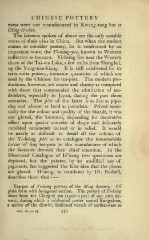Page 435 - Oriental Series Japan and China, Brinkly
P. 435
CHINESE POTTERY
mens were not manufactured in Kwang-tung but at
Ching-te-chen.
The faiences spoken of above are the only notable
wares of their class in China. But when the student
comes to consider pottery, he is confronted by an
important ware, the Ti-hsing-yao y known to Western
collectors as boccaro. Yi-hsing lies near the Western
shore of the Tai-wu Lake, a few miles from Shanghai,
up the Yang-tsze-kiang. It is still celebrated for its
terra cotta pottery, immense quantities of which are
used by the Chinese for tea-pots. The modern pro-
ductions, however, are coarse and clumsy as compared
with those that commanded the admiration of tea-
drinkers, especially in Japan, during the past three
centuries. The pate of the latter is as fine as pipe-
clay and almost as hard as porcelain. Prized essen-
tially for the colour and quality of the biscuit, it was
not glazed, the keramist, depending for decorative
effect upon quaint conceits of shape and delicately
moulded ornaments incised or in relief. It would
be nearly as difficult to detail all the colours of
the Yi-hsing pate as to catalogue the innumerable
forms of tiny tea-pots to the manufacture of which
the factories devoted their chief attention. In the
Illustrated Catalogue of H'siang two specimens are
depicted, but the painter, by an unskilful use of
pigments, has suggested the false idea that the pieces
are glazed. H'siang, as translated by Dr. Bushell,
describes them thus :
Tea-pot of Ti-hsing pottery of the Ming dynasty. Of
plain form with hexagonal section. The pottery of Ti-hsing
dates from the Ching-te era (15061521) of our own dy-
nasty, during which a celebrated potter named Kung-chun,
a native of the district, fashioned vessels of earthenware to
VOL. ix. 23 353

